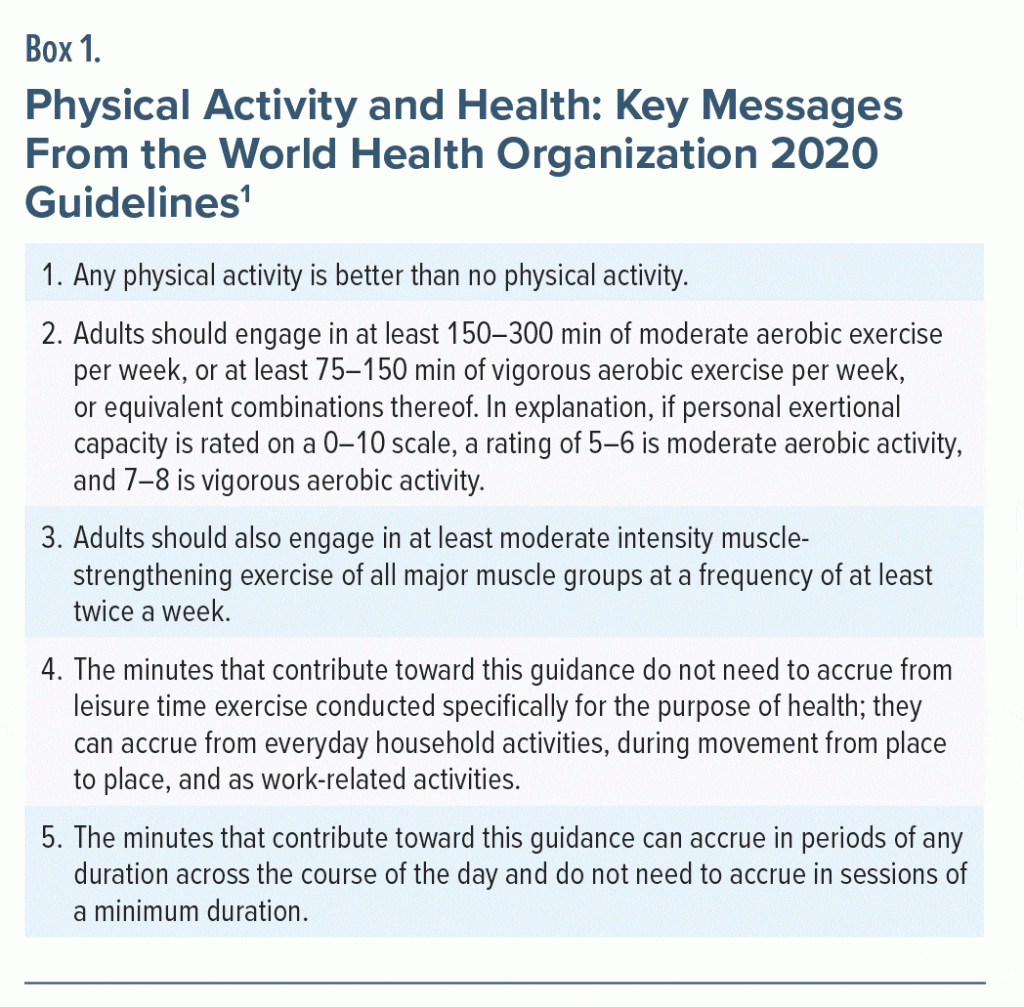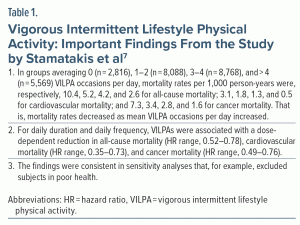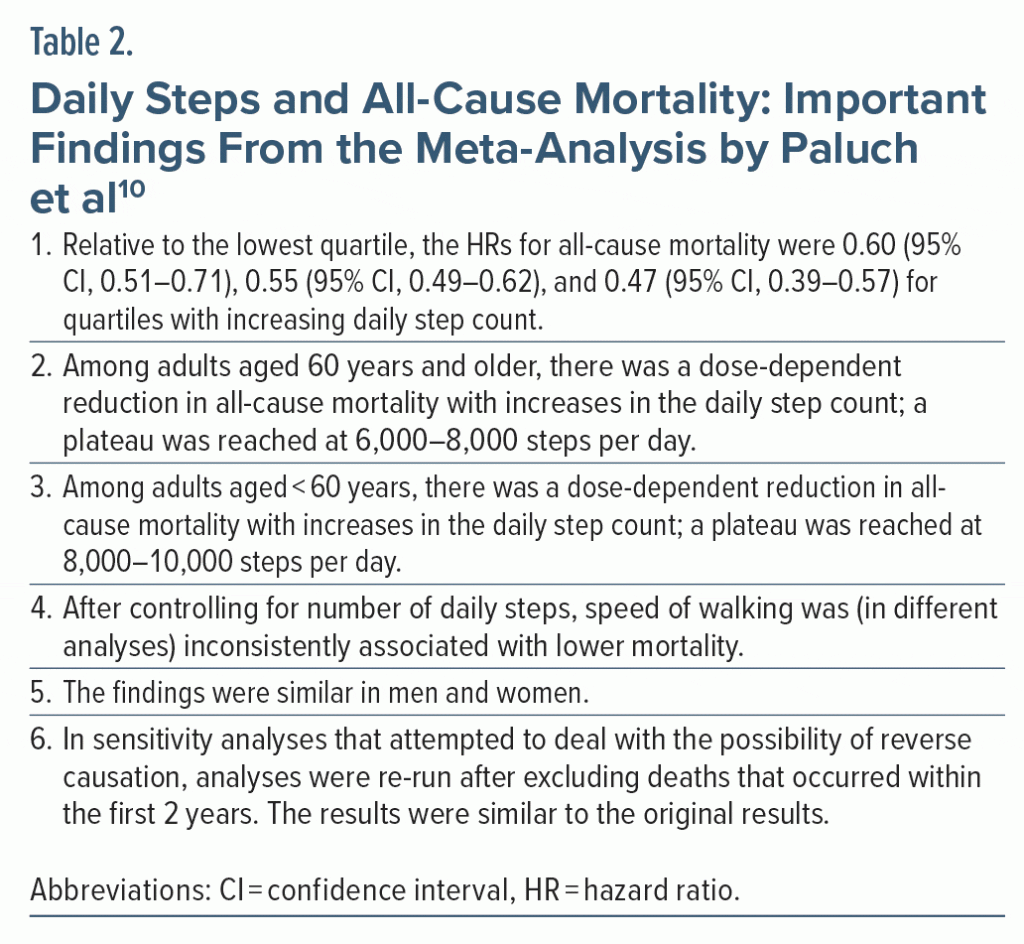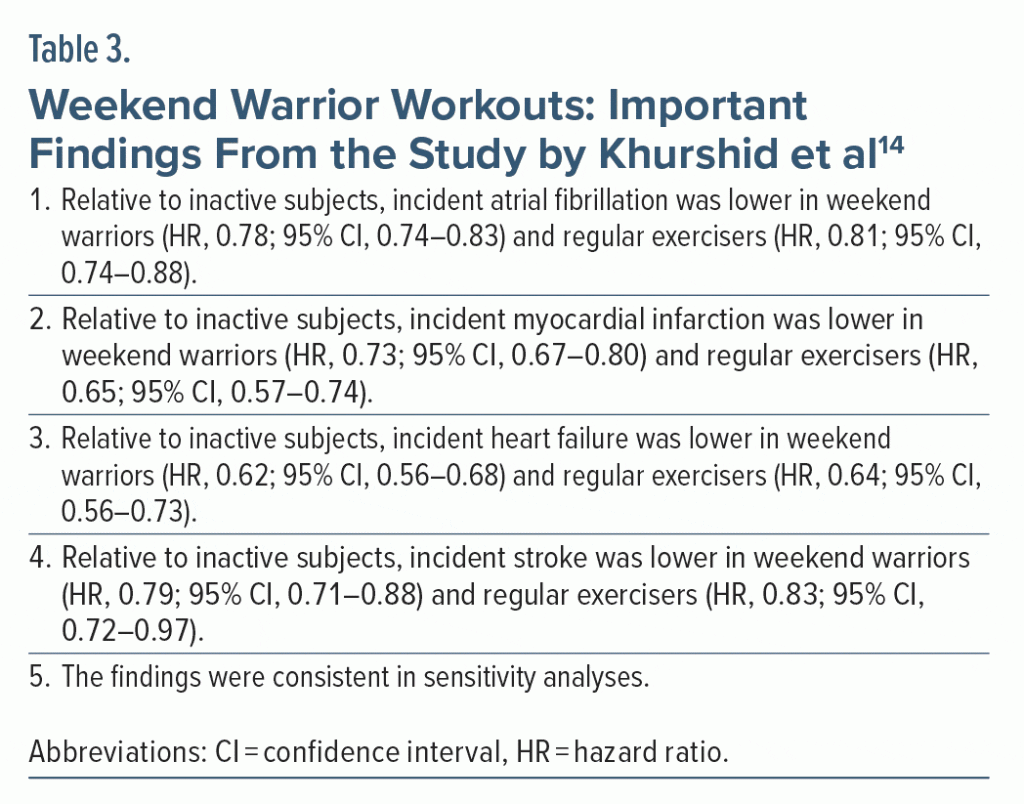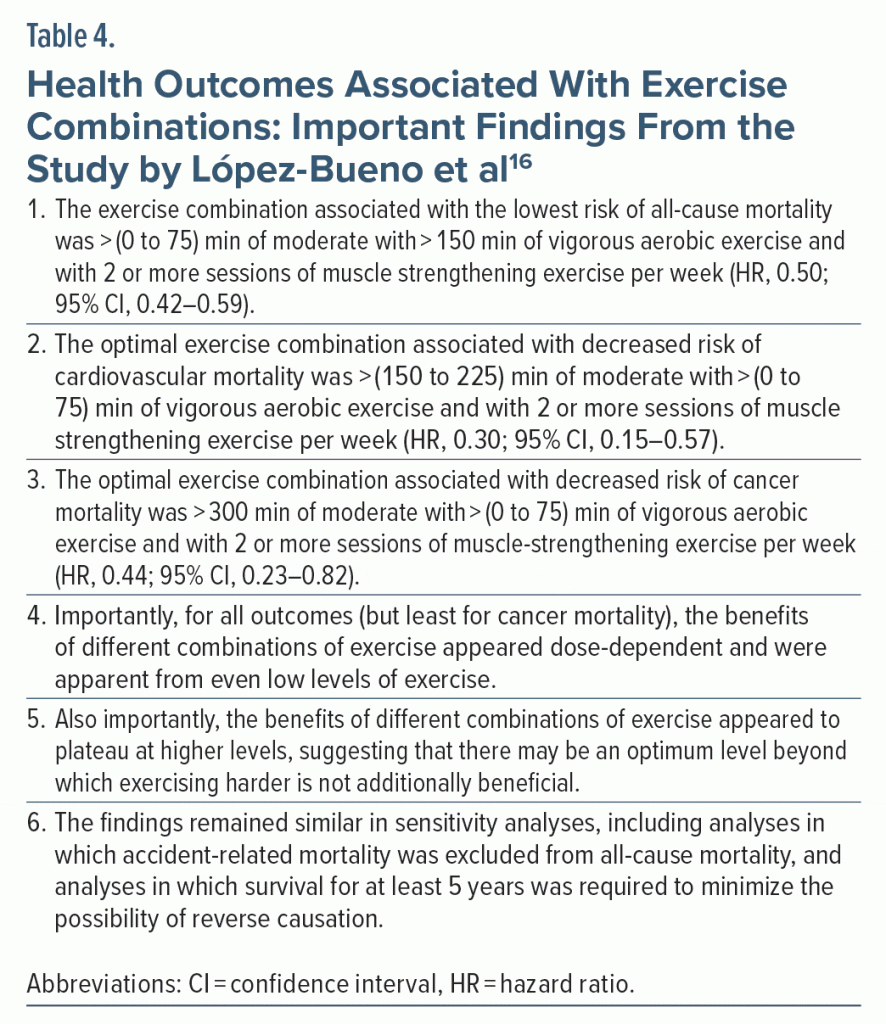ABSTRACT
Physical activity and leisure time exercise are associated with well-documented health benefits. Cohort studies and meta-analyses of such studies show that the benefits of physical activity are dose-dependent, arise at even low levels of activity, improve sharply from low to higher levels of activity, peak at very high levels of activity, and plateau thereafter. The benefits are apparent regardless of how the activity is accrued, from vigorous movements in very short intervals during everyday activities across the course of a day to vigorous, “weekend warrior” exercise, accumulated mostly during 1–2 days in a week. An earlier article in this column discussed terminology, guidance, benefits, and risks in the context of exercise and health. This article states and explains the guidance about exercise for adults and for special populations such as the elderly, discusses general limitations of cohort studies, examines how many steps of walking a day suffice to improve health outcomes and at what level a ceiling is reached, considers at what speed these steps need to accrue, examines the benefits of exercise patterns such as vigorous intermittent lifestyle physical activity and weekend warrior workouts, discusses a study that examined different combinations of exercise, and explains the reasons behind the paradox that fitter persons need to perform apparently harder workouts to meet the exercise guidance. Some niche issues are also discussed, such as a role for isometric exercise, the use of caffeinated and energy beverages before exercise, the use of target heart rate as a measure of exercise intensity, how to grade an exercise session that varies in intensity, and the importance of load-bearing, stability, balancing, and flexibility exercises. It must be understood that exercise is a lifetime commitment that provides benefits that pills cannot. Health care professionals need to recommend activity and discourage sedentariness in all patients whom they see.
J Clin Psychiatry 2023;84(5):23f15110
Author affiliations are listed at the end of this article.
See Part 1 in this series.
Physical activity and leisure time exercise are associated with well-documented health benefits. Formal recommendations have therefore been made for optimal levels of physical activity, summated across a week, for adults as well as for special demographic groups such as children and adolescents, the elderly, pregnant women, people with chronic illness, and people with disabilities.1 Nevertheless, studies conducted across the world show that large proportions of adolescents2 and adults3 are sedentary or fail to meet recommended thresholds for physical activity. This appears to be especially true in patients with major mental illness, who may lose up to 15 years of life due to comorbidities associated with sedentariness.4,5 It is therefore important for health care professionals in general, and mental health care professionals in particular, to discourage sedentary behaviors and encourage physical activity in patients whom they treat.
An earlier article in this column discussed terminology, guidance, benefits, and risks in the context of exercise and health.6 This article examines how much of physical activity or exercise is necessary to improve health outcomes, and what patterns and intensities of exercise are associated with health benefits. The key messages, reflecting current guidance, are presented in Box 1. These messages were explained in the previous article.6 These messages are illustrated in the present article using specific studies that were recently published. Issues arising from these studies are critically examined. General issues related to exercise and health benefits are also discussed.
Preliminary Notes on Studies of Health Outcomes Associated With Exercise
Almost all the studies have been observational cohort studies. In most studies, cohorts were followed for a mean (or median) of 5–10 years. So, it is not known what the relationship between physical activity and health outcomes might be in the longer term, such as after 15 or 20 years of follow-up. Unfortunately, it is not easy to conduct such long-term studies. One problem is that study participants drop out, and reasons for dropout are not necessarily random; if reasons for dropout are related to the study objectives, bias is introduced. Another concern is that people change their level of physical activity, and this is problematic because physical activity is the variable of interest. A third issue is that a multitude of other variables that can influence health outcomes appear, change, or disappear. There are other problems, too.
The long-term studies do not provide data on outcomes with specific forms of exercise, such as interval training vs continuous exercising at uniform intensity, or aerobic vs resistance training, or isotonic vs isometric training. Also, most long-term studies do not provide data on outcomes for men and women separately, and in different age bands separately. So, much of the guidance on exercise is based on an understanding of the physiological effects of exercise, on the results of short-term research, and on common sense.
Physical Activity: Small Efforts Count
Vigorous intermittent lifestyle physical activity (VILPA) refers to short bursts of vigorous physical activity that are part of daily life. VILPAs differ from regular leisure time physical exercise. Examples of VILPAs include walking fast between buildings at the workplace, climbing quickly up 1–2 flights of stairs, and moving heavy furniture across rooms. Such activities may each last just a minute or two. In this context, Stamatakis et al7 described an observational study that examined health outcomes related to VILPAs.
The data were drawn from the UK Biobank. The sample comprised 25,241 subjects who did not engage in formal leisure time physical exercise; who, at the most, went for 1 walk a week; and who survived for 2 years beyond baseline. The mean age of the sample was 62 (range, 40–69) years. The sample was 56% female. The mean body mass index (BMI) of the sample was 28. Only 9% of subjects were current smokers, but 33% of subjects were consuming alcohol above guideline levels.
These subjects wore wrist accelerometers for at least 16 h per day for 3–7 days (including at least 1 day during the weekend) at baseline. VILPA events were recorded in 89% of subjects; the median VILPA frequency was the equivalent of 3 occasions per day for 1–2 min per occasion. The maximum frequency was the equivalent of 11 such occasions in a single day. The mean VILPA duration was 6 min per day and the maximum duration was 18 min per day. VILPAs were more frequent among men.
Subjects were followed up for a mean of 6.9 years. During this period, 852 subjects died, 511 due to cancer and 266 due to cardiovascular events. Outcomes were compared between subjects with and without VILPAs, after adjusting for confounding variables. Important findings from the study are presented in Table 1.
In summary, in mostly overweight elderly persons who did very little physical activity, brisk activity for 1–2 min, several times a day (as part of daily activities rather than as scheduled physical exercise), was associated with a 22%–65% reduced risk of all-cause mortality, cardiovascular mortality, and cancer mortality across an average of 7 years of follow-up. The benefits were dose-dependent in terms of duration and frequency of these bursts of activity.
As positives, these encouraging findings suggest that VILPA can be recommended for those who, for whatever reason, do not meet recommended thresholds for physical activity. VILPA can also be recommended to those who are disinclined to engage in formal leisure time physical exercise. Finally, and for the same reason, given the age of the sample, VILPA can be recommended to the elderly.
The study had several strengths. As an example, the likelihood of reverse causation was reduced by excluding subjects who died within 2 years of study onset; in these subjects, low physical activity may have been the result of ongoing disease that led to mortality rather than a risk factor for mortality. As another example, VILPAs were recorded using accelerometers across 3–7 days of use; VILPAs cannot be accurately measured using questionnaires.
The study had several limitations. Only 6% of persons invited to participate in this study actually participated, and so the findings may not generalize to the population. There is no assurance that the VILPA and other activity levels, and the baseline variables adjusted for, remained unchanged across follow-up (however, the authors did confirm this in a small subsample). Finally, this was an observational study that is only as good as the extent and quality of adjustment for confounding; it cannot establish cause and effect.
There are several points on which the reader must ponder. The most important one is that, in terms of absolute numbers, the crude difference in all-cause mortality between lowest and highest VILPA groups was about 8 per 1,000 person-years or, for an individual subject, only 0.08 per decade (Table 1). Although statistically significant and important at a population level, the benefit for an individual appears very small. What the absolute survival benefit may be after adjustment for confounding variables is unknown. Another point of importance is that the study findings should not be interpreted to suggest that a few VILPAs a day suffice for health. This is because the threshold for identification of benefit was very low—the reference group comprised persons who did not exercise at all and who recorded no VILPAs, either; that is, persons whose health outcomes could very easily be improved upon. Regular, vigorous physical exercise would surely be associated with better outcomes than merely a few VILPAs a day. So, what the findings really indicate is that a few VILPAs a day could marginally reduce the mortality risk across 7 years in persons who have very low levels of activity. Last but not least, the health benefits of VILPAs could differ in health care environments that differ in quality and efficiency from that of the UK Biobank sample. Thus, it is uncertain whether VILPAs would make a difference to mortality rates in environments characterized by low income, poor nutrition, and poor health care.
In a near-identical study conducted on much the same population with much the same demographics, VILPA was dose-dependently associated with reduction in the incidence of both total cancer and cancers specifically related to physical activity; relative to no VILPA, across 6.7 years of follow-up, VILPA of 4.5 min/d was associated with a hazard ratio (HR) of 0.69 (95% confidence interval [CI], 0.55–0.86) for cancers related to physical activity and an HR of 0.80 (95% CI, 0.69–0.92) for total cancer. Here, cancers related to physical activity included cancers of the liver, lung, kidney, stomach, endometrium, head and neck, breast, and bladder, as well as myeloid leukemia, esophageal adenocarcinoma, and colorectal cancer.8
The bottom line is that VILPAs are better than no VILPAs, but the target should be VILPAs only when a more ambitious target is not possible.
Physical Activity: How Many Steps and at What Speed?
The easiest way to exercise is to walk. Walking is safe, even for persons with medical illnesses; the World Health Organization (WHO) guidelines state that almost everybody can walk for exercise without obtaining prior medical clearance.1
There is a widely held belief that we need to walk 10,000 steps a day for health. This belief is probably related to commercial devices and media propagation rather than evidence.9 So, how much should we walk, and at what pace? These questions were examined in a systematic review and individual participant data meta-analysis by Paluch et al.10
These authors10 searched online databases and other sources and identified 7 published and 8 unpublished cohort studies from which individual participant daily step count and its effect on mortality could be obtained. The pooled sample comprised 47,471 adults. The mean age of the sample was 65 years. The sample was 68% female. The median follow-up duration was 7.1 years. There were 3,013 deaths during follow-up.
The sample was divided into quartiles with medians of 3,553, 5,801, 7,842, and 10,901 steps per day. Analyses were conducted with adjustment for confounding variables. Important findings from the meta-analysis are presented in Table 2.
In summary, across about 7 years of follow-up, higher daily step count was dose-dependently associated with lower all-cause mortality up to a ceiling of 6,000–8,000 steps per day for persons aged ≥ 60 years and 8,000–10,000 steps per day for persons aged < 60 years. The findings did not differ between men and women. There was no clear signal that the speed of walking mattered.
As a noteworthy point, counting daily steps is an unstandardized measure. The count obtained can vary by up to 20% or more based on what device is used, on which part of the body it is worn, on how fast one walks, and on other variables.10 So, the guidance on absolute step count must be deemed approximate rather than precise.
The important message is that whereas one must aim for a target of 6,000–10,000 steps a day, depending on age, even lower daily step counts are associated with reduced mortality risk. This emerged from other meta-analyses, as well. For example, in 17 cohort studies (pooled N = 226,889) with a median follow-up of 7.1 years, significant reduction in cardiovascular mortality was observed at a count as low as about 4,000 steps per day, and significant reduction in all-cause mortality was observed at a count as low as about 5,500 steps per day; higher daily step count was associated with greater benefit.11
Physical Activity: Is a Target of 40 Push-Ups Enough?
If even low levels of physical activity are associated with health benefits, is a target of 40 push-ups sufficient? In a sample of 1,104 male firefighters (mean age, 40 years), relative to those who could do up to 10 push-ups, those who could do > 40 push-ups were at a substantially lower risk of incident cardiovascular disease, or events related thereto, at a 10-year follow-up (incidence rate ratio [IRR], 0.04; 95% CI, 0.01–0.36).12 So, can we conclude that a target of exercise is to be able to do > 40 push-ups, without stopping, at a metronome speed of 80 per min, as in this study? Surely not; achieving just this endpoint without performing any other exercise amounts to just 30 s of exercise, and 30 s of just one kind of exercise per day is very unlikely to result in tangible health benefits.
This is an excellent example of how the Bradford Hill criteria,13 explained in the earlier article in this series,6 can be applied to judge whether an observed relationship describes cause and effect or is merely a significant association driven by other variables; this study fails to establish cause and effect on almost every criterion. This study is also an excellent example of why the earlier article6 stated that every study should be weighed on its own merits.
To their credit, the authors of this study12 did not present their findings as cause and effect. Regrettably, they presented only the IRR statistic in their abstract, a section of a paper at which most readers stop. A limitation of the IRR is that it is an unadjusted statistic. The authors failed to state in their abstract that, in analyses adjusted for age and BMI, relative to doing up to 10 push-ups, only the 21–30 push-up category (and not the 11–20, 31–40, and > 40 push-up categories) was associated with significantly better cardiovascular outcomes during follow-up.
The bottom line is that exercise abilities are not exercise targets; they are merely markers of future health outcomes. Exercise targets should be meeting the recommendations stated in guidelines.1
Physical Activity: Weekend Warrior Workouts
Many people have work, family, and other responsibilities during weekdays that do not allow them time to exercise. So, can doing long and hard workouts during the weekend compensate? That is, are weekend warrior workouts associated with health benefits? The answer is yes.
As an example, in a retrospective cohort study14 of data from the UK Biobank, 89,573 subjects were followed for a median of 6.3 years. The mean age of the cohort was 62 years. The sample was 56% female. There were 37,872 (42.2%) weekend warriors, 21,473 (24.0%) regular exercisers, and 30,228 (33.7%) inactive subjects. Weekend warriors were those who performed ≥ 150 min of moderate to vigorous physical activity a week with ≥ 50% of the activity accruing in 1–2 days. Regular exercisers were those who performed ≥ 150 min of moderate to vigorous physical activity a week with the activity more evenly distributed across the week. Inactive subjects were those who were moderately to vigorously active for < 150 min a week. This classification was based on accelerometry data and not on self-report. The analyses were adjusted for important confounding variables. The results are presented in Table 3.
In summary, in this elderly cohort, subjects who met their physical activity threshold mostly during 1–2 days in a week and subjects who met their threshold in more regularly spread workouts showed similar, significant reductions in the risk of atrial fibrillation, myocardial infarction, heart failure, and stroke across 6.3 years of follow-up.
These findings are encouraging for several reasons. One is that weekend warrior workouts were associated with health benefits; this is important because, at least in this sample, more than half of persons who met exercise guidance showed weekend warrior workout patterns. The second is that the benefits of weekend warrior workouts were similar to those with more regularly spread exercising. The third is that the comparison group was not truly inactive; persons in the group merely did not meet the 150 min per week threshold for moderate to vigorous physical exercise. That is, the benefits in the exercising groups were evident even relative to a group that may have been exercising, but at lower levels. These findings offer hope for persons who, for whatever reasons, cannot exercise regularly. Caveats and other noteworthy points are similar to those discussed for the VILPA study, earlier in this article.
Confirming the findings, in a systematic review and meta-analysis,15 relative to inactive subjects, weekend warriors had a lower risk of cardiovascular disease mortality (relative risk [RR], 0.73; 95% CI, 0.60–0.90; 2 studies; N = 414,569) and all-cause mortality (RR, 0.83; 95% CI, 0.77–0.90; 4 studies; N = 426,428). These results were very closely similar to those obtained for regular exercisers.
Physical Activity: Exercise Combinations
People who exercise may walk, cycle, climb stairs, jog, or run; these are examples of aerobic exercise. They may do planks, squats, crunches, press-ups, or weightlifting; these are examples of muscle strengthening exercise. And, they may do these different kinds of exercise in combination. When people do different kinds of exercise with different intensities and in different combinations, is it possible to determine which combination might be the best? This question was examined by López-Bueno et al16 in a nationwide prospective observational cohort study, using data from the US National Health Interview Survey for the period 1997–2018.
The sample comprised 500,705 adults who were free from chronic illness or exercise-precluding disability at baseline. The mean age of the sample was 46 years. The sample was 58% female and 77% white. These subjects were followed for a median of 10 years.
Exercise was assessed through self-report, obtained only at baseline, and was classified as moderate or vigorous aerobic exercise, cumulated into minutes per week. Muscle strengthening exercise was dichotomized as less than 2 or at least 2 occasions per week.
Study outcomes were all-cause mortality, cardiovascular mortality, and cancer mortality. Subjects who experienced an outcome within 2 years were excluded from analysis (5 years, in sensitivity analyses) in order to reduce the possibility of reverse causation. Analyses were adjusted for age, sex, race, marital status, education, smoking status, alcohol intake status, presence of diabetes or hypertension, BMI, and others. The reference group (35% of the sample) comprised subjects doing no moderate or vigorous aerobic exercise and doing muscle strengthening exercise less often than twice a week. Exercise groups comprised various combinations of intensity and duration of aerobic exercise, along with, or without, muscle strengthening exercise. Important findings from the study are presented in Table 4.
In summary, in this sample of middle-aged subjects followed for about 10 years, roughly 3–6 hours per week of moderate to vigorous aerobic exercise in combination with at least 2 sessions per week of muscle strengthening exercise was associated with the best (half to two-thirds) reductions in the 10-year risk of cancer mortality, cardiovascular mortality, and all-cause mortality. The benefits of different combinations of exercise intensity were dose-dependent, were apparent even at low levels of exercise, and appeared to plateau at higher levels.
A noteworthy point is that the exact combination for optimal benefit is almost certainly not set in stone; other studies would probably find other combinations to be associated with the best outcomes. What did emerge was that, at lower levels of activity, either more intense aerobic exercise or longer duration of aerobic exercise, in combination of muscle-strengthening exercise, was associated with lower mortality risks. What this means is that, at lower levels of exercising, if vigorous exercise is not possible, longer exercise duration will improve outcomes; and if longer exercise durations are not possible, more vigorous exercise will improve outcomes. Thus, in a way, the findings of this study support the WHO guidelines that recommend at least 150–300 min of moderate aerobic exercise per week or at least 75–150 min of vigorous aerobic exercise per week, or equivalent combinations thereof, along with muscle-strengthening exercise at a frequency of at least twice a week.1
Another noteworthy point is that few people in the population would meet the high levels of physical activity found to be the “best” in this study. Happily, even lower levels of exercise were associated with substantial benefit. Also noteworthy is that the benefits of different combinations of exercise were dose-dependent, were apparent even at lower levels of exercise, and appeared to plateau at higher levels. Such dose-dependent effects of exercise are well-documented in meta-analyses, and, importantly, persons exercising at lower levels show the steepest improvements in benefit.17,18 This means that people who do little exercise stand to gain much by increasing their level of exercise.
In this study,16 muscle-strengthening activity was operationalized as any activity that was specifically intended to strengthen muscles; no time duration for the activity was specified. Moderate physical activity was operationalized as leisure-time physical activity that was at least 10 min in duration, per occasion, and associated with a moderate increase in sweating, breathing, and heart rate. Vigorous physical activity was operationalized as leisure-time activity that was at least 10 min in duration, per occasion, and associated with a substantial increase in sweating, breathing, and heart rate. A limitation of these operationalizations is that people who were active for shorter durations, and those who were active but not during leisure-time activity, would have been classified as reference group subjects. This would have decreased the ability of the analyses to detect significant benefits of exercise, and to detect the full magnitude of exercise-related benefit. Other limitations are similar to those considered in the VILPA section, earlier.
The Exercise Paradox
In the study16 described in the previous section, moderate physical activity was defined as activity that resulted in a moderate increase in sweating, breathing, and heart rate, and vigorous physical activity as activity that resulted in a substantial increase in sweating, breathing, and heart rate; that is, the effect of the activity on the body rather than the intensity of the activity to an observer was the defining element. The WHO guidelines (Box 1) also make it clear that moderate and vigorous aerobic exercise are defined by personal rather than objective assessment. Thus, rating of exercise intensity is not an objective target of what exercise is performed and at what rate.
This subjectivity or personalization of definition leads to the paradox that people who are very fit would need to do higher intensities of exercise to meet their perception of higher intensity, or their thresholds for sweating, breathing, and heart rate. Consider that, for an average person, running a kilometer in 5–6 min is vigorous aerobic exercise; for a professional athlete, this is merely a warming-up exercise. So, if exercise intensity is a measure of exercise-related benefits, why is the same exercise less beneficial in persons who are more fit? Stated differently, why is fitness punished by the imposition of a heavier exercise burden in order to meet the definition of adequacy?
A simple physiological answer explains the paradox. For exercise to be of benefit, it must actually exercise muscles. So, what is important is not what exercise one does (eg, running 1 kilometer in 5–6 min) but what that exercise does to the muscles of the body and especially the muscles of the heart, with downstream impact on other anatomic structures and physiological processes in the body. This is why a professional athlete needs to seemingly work out harder to qualify for the recommended thresholds for the desired cardiovascular benefits.
It is therefore important for people to understand that when they improve their level of fitness, they will need to work out (to the observer) harder to continue to meet their personal thresholds. This may seem unfair but it is not really so; if doing more exercise and at a faster rate is not experienced as difficult, it is not a burden. More importantly, the higher level of fitness will mean that the body can tolerate a higher level of physiological stress. As an example, greater fitness is associated with higher heart rate reserve, which in turn is associated with a lower risk of cardiovascular mortality.19
Isotonic and Isometric Exercise
Isotonic exercises are those that are associated with repetitive shortening and lengthening of muscles during the course of exercise and hence with repetitive movements at joints. Running, swimming, and climbing stairs are examples of isotonic exercise. Push-ups, crunches, and biceps curls are also examples of isotonic exercise. Thus, all aerobic and most muscle strengthening exercises are isotonic in nature.
Isometric exercises are those that hold muscles in a state of tension without shortening and lengthening of muscles. There is therefore no movement at joints. Planks, bridges, and wall squats are examples of isometric exercises. Yoga, which requires positions to be reached and maintained, is also mostly isometric. All isometric exercises are muscle strengthening exercises; there is negligible aerobic element.
Isometric exercises result in an acute increase in blood pressure20 but in long-term decrease in systolic and diastolic blood pressure.21 In this regard, they are no different from isotonic exercises that also raise blood pressure acutely22 but result in lowered blood pressure in the long term.23
Isotonic exercises are recommended as the default form of exercise. This is because they mimic natural movements and activities in everyday life. Isometric exercises are not recommended as a routine. This is because there is little activity in everyday life that involves holding parts of the body in specific positions. However, isometric exercises are useful for persons with muscle or joint injuries, or other disease, who cannot perform exercises that involve shortening and lengthening of muscles and movements at joints.
Beverage-Assisted Exercise
Tailwinds improve athletic performance in certain track and field events, but the improved performance is not true performance. So, when exercise is improved by caffeine or energy drinks, does the improved performance count toward health benefits? The answer, surprisingly, is almost certainly yes. This is because studies that examined the relationship between exercise intensity and health benefits did not examine whether the ascertained or self-reported exercise intensities had been assisted by caffeine or energy drinks. Given that caffeinated and energy sports drinks have been available for decades, chances are that many regular exercisers were drinking coffee or using these drinks before a vigorous session in the gym. So, research findings probably apply to exercise in general, regardless of concurrent coffee or energy drink use.
Adequate food intake improves the quality of an exercise session, and energy drinks provide additional calories that are immediately available to burn during exercise. Furthermore, caffeine in such drinks improves the intensity of an aerobic workout. For the body, it is the workout that matters, and not the means by which the workout was obtained. That is, if the heart muscles have been exercised harder and for longer, they become stronger regardless of how the exercise was fueled and driven.
Some caveats are in order. Energy drinks are high in sugar content, and it is now recognized that added sugar is detrimental to health. Energy drinks are also associated with cardiovascular and other adverse effects.24,25 Finally, a heart and body that perform well with assistance from energy drinks may not perform as well when physiologically stressed in the absence of such assistance.
Other Notes and Comments About Exercising
Simple as well as elaborate methods have been suggested to define the ideal minimum and maximum target heart rates for moderate or vigorous aerobic exercise. These methods use age or age and basal heart rate as the moderator(s) for the calculations. These methods require monitoring of the heart rate during exercise, which is not easy to accurately do. These methods are also vulnerable to variables, such as disease and drug treatments, that can affect the basal heart rate and its ability to respond to exercise. There does not appear to be a clear advantage with these heart rate methods relative to other methods. The method suggested in the WHO guidelines1 and presented in Box 1 may therefore be the simplest and best method to plan or rate exercise intensity.
Nobody exercises at the same intensity all through an aerobic exercise session. It is common for the intensity to be low initially, moderate thereafter, and intense, in a burst, at the end. It is also common for persons to start with an enthusiastic burst, slow down to moderate intensity, and peter out toward the end. Some forms of exercise, such as interval training, are performed only in bursts, with periods of rest in between. So, how does one quantify in minutes the different intensities of workout during a session? There is no good answer here. A reasonable solution would be to rate the overall intensity of the workout, or the average intensity of the largest segment of the workout, using the WHO guidelines method.1 If, however, the heart rate returns to baseline in between bursts of exercise, and if the intervals between bursts are long, then including the intervals between bursts may not be appropriate when rating the intensity and duration of the session. This detail has not been specifically addressed in studies.
Most aerobic exercises are a combination of aerobic and muscle strengthening exercises. For example, cycling uphill accelerates the heart rate and speeds up respiration; it is emphatically aerobic. However, cycling uphill also strengthens the muscles of the lower limbs. Likewise, although swimming, dancing, rowing, and climbing stairs are aerobic activities, they do strengthen muscles. Exercises that are designed to be muscle-strengthening, however, speed up the heart rate but are generally low in aerobic value because the increase in heart rate is usually small and the duration for which the heart rate is elevated is brief.
An aerobic exercise session that has muscle strengthening components is generally not included in the recommended “2 muscle strengthening sessions per week” quota.1 To meet the definition, strength training optimally requires the exercise of all major muscle groups and is best performed in repetitions. One or two sets of repetitions of exercise of each muscle group should suffice for a session provided that it results in at least a modest sense of tiredness in that muscle group.
Whether aerobic or muscle strengthening, good exercises include a load-bearing component. When walking, running, or climbing stairs, the load is one’s own body. When cycling or swimming, the bicycle or the buoyancy of the water reduces load bearing. Load bearing is important because it helps strengthen bones. Muscle strengthening exercises of different muscle groups help strengthen the bones involved in the movements mediated by those muscle groups. Improving or at least maintaining bone strength is important because stronger bones are less likely to be vulnerable to fracture in the event of falls or direct injury. Load-bearing exercise is therefore important for the retardation of osteoporosis in those vulnerable to osteoporosis. However, after onset of significant osteoporosis, load-bearing exercise should be performed only after medical consultation lest the exercise result in injury. Thus, lifting weights and bending and twisting exercises may be proscribed.
Stability and balancing exercises are important, especially among older persons, to reduce the risk of falls and consequent injuries. Older persons also need to do an extra session of muscle strengthening exercise, each week, to compensate for age-related decrease in muscle mass. Stronger muscles in the lower limbs also improve stability and reduce the risk of falls. Finally, stretching exercises are important to improve flexibility, mobility, and range of movement around joints.
Parting Note
Exercise is a lifetime commitment. The benefits of exercise will eventually disappear if exercise is stopped. This should not come as a surprise; after all, the benefits of food will also eventually disappear if food is stopped.
It is easy to take pills to reduce blood sugar and serum lipid levels. Exercise requires motivation and effort; it does not come as pills. However, there are no pills to strengthen heart muscles, skeletal muscles, and bones; to improve stability and balance; to reduce the risk of cancer and other diseases; and to improve other health outcomes. So, regular, lifelong exercise is necessary for health and should be embraced by all. Health care professionals should impart this knowledge and aim to increase levels of exercise and reduce sedentariness in patients whom they see.
Article Information
Published Online: October 11, 2023. https://doi.org/10.4088/JCP.23f15110
© 2023 Physicians Postgraduate Press, Inc.
To Cite: Andrade C. Physical exercise and health, 2: benefits associated with different levels and patterns of activity. J Clin Psychiatry. 2023;84(5):23f15110.
Author Affiliations: Department of Clinical Psychopharmacology and Neurotoxicology, National Institute of Mental Health and Neurosciences, Bangalore, India ([email protected]).
 Each month in his online column, Dr Andrade considers theoretical and practical ideas in clinical psychopharmacology with a view to update the knowledge and skills of medical practitioners who treat patients with psychiatric conditions.
Each month in his online column, Dr Andrade considers theoretical and practical ideas in clinical psychopharmacology with a view to update the knowledge and skills of medical practitioners who treat patients with psychiatric conditions.Department of Clinical Psychopharmacology and Neurotoxicology, National Institute of Mental Health and Neurosciences, Bangalore, India ([email protected]).
Financial disclosure and more about Dr Andrade.
References (25)

- Bull FC, Al-Ansari SS, Biddle S, et al. World Health Organization 2020 guidelines on physical activity and sedentary behaviour. Br J Sports Med. 2020;54(24):1451–1462. PubMed CrossRef
- Guthold R, Stevens GA, Riley LM, et al. Global trends in insufficient physical activity among adolescents: a pooled analysis of 298 population-based surveys with 1·6 million participants. Lancet Child Adolesc Health. 2020;4(1):23–35. PubMed CrossRef
- Guthold R, Stevens GA, Riley LM, et al. Worldwide trends in insufficient physical activity from 2001 to 2016: a pooled analysis of 358 population-based surveys with 1·9 million participants. Lancet Glob Health. 2018;6(10):e1077–e1086. PubMed CrossRef
- Vancampfort D, Firth J, Schuch FB, et al. Sedentary behavior and physical activity levels in people with schizophrenia, bipolar disorder and major depressive disorder: a global systematic review and meta-analysis. World Psychiatry. 2017;16(3):308–315. PubMed CrossRef
- Bort-Roig J, Briones-Buixassa L, Felez-Nobrega M, et al. Sedentary behaviour associations with health outcomes in people with severe mental illness: a systematic review. Eur J Public Health. 2020;30(1):150–157. PubMed
- Andrade C. Physical exercise and health, 1: an overview of terminology, guidance, benefits, and risks. J Clin Psychiatry. 2023;84(5):23f15099.
- Stamatakis E, Ahmadi MN, Gill JMR, et al. Association of wearable device-measured vigorous intermittent lifestyle physical activity with mortality. Nat Med. 2022;28(12):2521–2529. PubMed CrossRef
- Stamatakis E, Ahmadi MN, Friedenreich CM, et al. Vigorous intermittent lifestyle physical activity and cancer incidence among nonexercising adults: The UK Biobank Accelerometry Study. JAMA Oncol. 2023;e231830. PubMed CrossRef
- Lee IM, Shiroma EJ, Kamada M, et al. Association of step volume and intensity with all-cause mortality in older women. JAMA Intern Med. 2019;179(8):1105–1112. PubMed CrossRef
- Paluch AE, Bajpai S, Bassett DR, et al; Steps for Health Collaborative. Daily steps and all-cause mortality: a meta-analysis of 15 international cohorts. Lancet Public Health. 2022;7(3):e219–e228. PubMed CrossRef
- Banach M, Lewek J, Surma S, et al. The association between daily step count and all-cause and cardiovascular mortality: a meta-analysis. Eur J Prev Cardiol. 2023;zwad229. PubMed CrossRef
- Yang J, Christophi CA, Farioli A, et al. Association between push-up exercise capacity and future cardiovascular events among active adult men. JAMA Netw Open. 2019;2(2):e188341. PubMed CrossRef
- Hill AB. The environment and disease: association or causation? Proc R Soc Med. 1965;58(5):295–300. PubMed CrossRef
- Khurshid S, Al-Alusi MA, Churchill TW, et al. Accelerometer-derived “weekend warrior” physical activity and incident cardiovascular disease. JAMA. 2023;330(3):247–252. PubMed CrossRef
- Kunutsor SK, Jae SY, Laukkanen JA. ‘Weekend warrior’ and regularly active physical activity patterns confer similar cardiovascular and mortality benefits: a systematic meta-analysis. Eur J Prev Cardiol. 2023;30(3):e7–e10. PubMed CrossRef
- López-Bueno R, Ahmadi M, Stamatakis E, et al. Prospective associations of different combinations of aerobic and muscle-strengthening activity with all-cause, cardiovascular, and cancer mortality. JAMA Intern Med. 2023;183(9):982–990. PubMed CrossRef
- Ekelund U, Tarp J, Steene-Johannessen J, et al. Dose-response associations between accelerometry measured physical activity and sedentary time and all cause mortality: systematic review and harmonised meta-analysis. BMJ. 2019;366:l4570. PubMed CrossRef
- Garcia L, Pearce M, Abbas A, et al. Non-occupational physical activity and risk of cardiovascular disease, cancer and mortality outcomes: a dose-response meta-analysis of large prospective studies. Br J Sports Med. 2023;57(15):979–989. PubMed CrossRef
- Engeseth K, Hodnesdal C, Grundvold I, et al. Heart rate reserve predicts cardiovascular death among physically unfit but otherwise healthy middle-aged men: a 35-year follow-up study. Eur J Prev Cardiol. 2016;23(1):59–66. PubMed CrossRef
- Swift HT, O’Driscoll JM, Coleman DD, et al. Acute cardiac autonomic and haemodynamic responses to leg and arm isometric exercise. Eur J Appl Physiol. 2022;122(4):975–985. PubMed CrossRef
- Edwards JJ, Deenmamode AHP, Griffiths M, et al. Exercise training and resting blood pressure: a large-scale pairwise and network meta-analysis of randomised controlled trials. Br J Sports Med. 2023:bjsports-2022–106503.
- Nystoriak MA, Bhatnagar A. Cardiovascular effects and benefits of exercise. Front Cardiovasc Med. 2018;5:135. PubMed CrossRef
- Saco-Ledo G, Valenzuela PL, Ruiz-Hurtado G, et al. Exercise reduces ambulatory blood pressure in patients with hypertension: a systematic review and meta-analysis of randomized controlled trials. J Am Heart Assoc. 2020;9(24):e018487. PubMed CrossRef
- Basrai M, Schweinlin A, Menzel J, et al. Energy drinks induce acute cardiovascular and metabolic changes pointing to potential risks for young adults: a randomized controlled trial. J Nutr. 2019;149(3):441–450. PubMed CrossRef
- de Souza JG, Del Coso J, Fonseca FS, et al. Risk or benefit? Side effects of caffeine supplementation in sport: a systematic review. Eur J Nutr. 2022;61(8):3823–3834. PubMed CrossRef
This PDF is free for all visitors!
